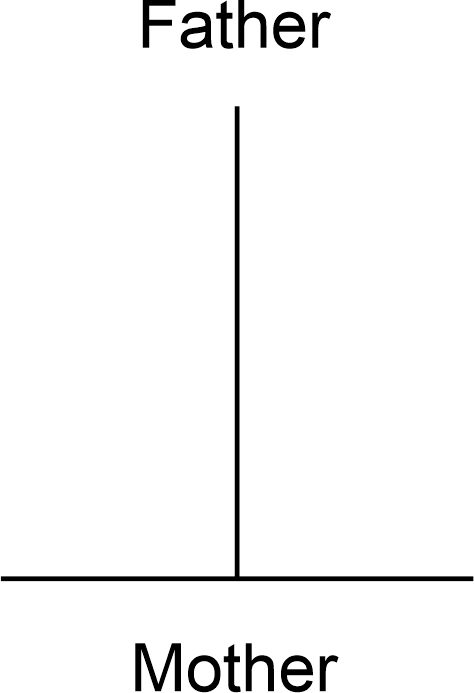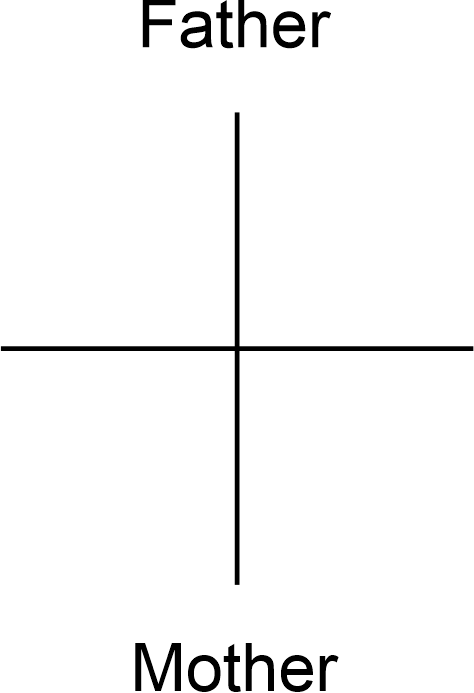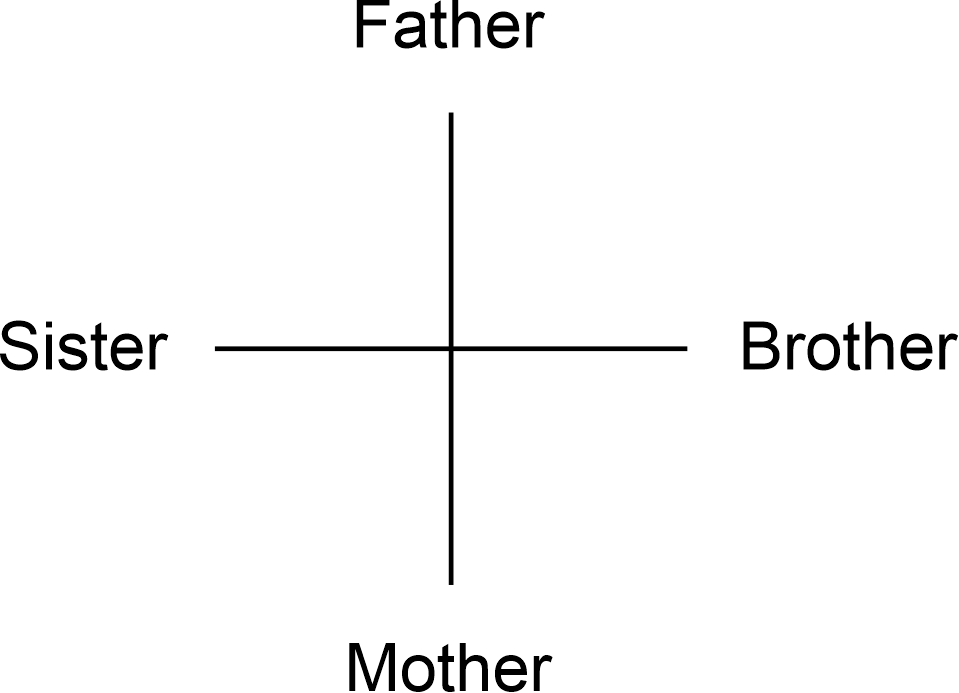- Title: Contemplations, 'Sister' and 'Brother'.
- Author: Arvindus.
- Publisher: Arvindus.
- Copyright: Arvindus, 2015, all rights reserved.
- Index: 201502241.
- Edition: html, first edition.
Esotericism
In the earlier contemplation 'An Etymosophy of 'Father' and 'Mother'' were the words 'father' and 'mother' etymosophically contemplated.1 It was found that they are phonetically, compositionally, semantically and symbolically polar opposites. Phonetically they are polar opposites because the 'p' as a basic bilabial plosive is opposed to the 'm' as a basic bilabial nasal. Compositionally they are polar opposites because the two words can be considered to consist of the aforementioned opposing phonetics 'p' and 'm' and the word 'other', making them readable as the 'pa-other' and the 'ma-other'. The semantic polar opposition of 'father' and 'mother' is obvious because a father is the opposite pole of a mother. Most interesting was probably their symbolical polar opposition. The father principle was contemplated to symbolize spirit and the mother principle matter, which are the two primal polar opposites of the ageless wisdom. Now as has been contemplated in other contemplations does the uniting of spirit and matter bring a third given to being, namely consciousness or creation.2, 3 This third given is in line with the aforementioned symbols mentioned as the 'son-principle'. This however is coloured by Christian thought in which Jesus Christ as the third given is posited as the son of the heavenly Father and the Holy Ghost.4 Without this Christian influence this third given can very well be symbolized by a non gender specific child-principle. So the uniting of father spirit and mother matter then brings forth the child consciousness.
Now in the ageless wisdom this polar opposition is geometrically symbolized by lines. Father spirit is there symbolized by a vertical line and mother matter by a horizontal.5 This is shown in figure 1.

Figure 1.
Now these two lines do not only symbolize geometrically the lines of the father and the mother but also serve purpose to show their polarity. For the horizontal line (especially when used within a unity symbolizing circle) divides between a father spirit above and a mother matter below,6 and the vertical line keeps father spirit ultimately above separated from mother matter ultimately below. When then the vertical father spirit and the horizontal mother matter unite they produce the cross of the child consciousness or the child creation,7 as shown in figure 2.

Figure 2.
Now so far we have only considered the child as the result of its causal duality of father and mother. However the child can also be considered as the cause of a resulting duality. For a child holds within itself the duality of sister and brother. A child is more primal than a sister and a brother. For every sister is (or was) a child, but not every child is (or was) a sister. And this goes for a brother as well. In relation to each other is childhood the necessary factor and are sisterhood or brotherhood the contingent factors. So on this base is the child the cause of a resulting duality. This resulting duality of sister and brother then can be placed at both ends of the horizontal line, rendering a picture as in figure 3.

Figure 3.
The vertical father line now is as father-mother the cause of the child and the horizontal mother line now is as sister-brother the result of the child. When we express ourselves thus we should not make the mistake of thinking of the mother as the result of the child. It is only the motherly duality which should be thought of as its result, not the mother as part of the fatherly duality of father-mother.
Perhaps things become more clear when we think of the father-mother duality as a qualitative duality and of the sister-brother duality as a quantitative duality and forget for a moment about the vertical line being termed 'fatherly' and the horizontal line 'motherly'. The vertical line then simply depicts the relation between a prime qualitative duality and the horizontal line the relation between a prime quantitative duality.
Now a duality is the prime differentiation of a unity lying at the base of every further differentiation.8 And the prime qualitative duality of spirit and matter can be found further differentiated in the seven planes, consisting from high to low of the divine, monadic, atmic, buddhic, mental, astral and physical planes.9 These aforementioned planes can be depicted as horizontal lines, each placed at a specific height on the prime vertical line.
Now with figure 3 taken in consideration it can be deduced that each of the aforementioned planes knows a certain quantitative duality. As an example can the experiences of pleasure and pain on the physical and emotional (astral) planes be mentioned, however in this contemplation we shall not work out all these dualities and keep the focus on quantitative duality as such. And as mentioned can this duality be symbolized by the sister-brother duality.
Etymosophy
That it is reasonable to take sisterhood and brotherhood as a symbol of quantitative duality is acknowledged by an etymosophical consideration of these words in relation to the earlier contemplated 'father' and 'mother'. In that earlier contemplation were 'father' and 'mother' presented as the 'pa-other' and the 'ma-other' whereby the two are primarily other towards and for each other. Both of the words have with minor phonetic adjustments the word 'other' in them. Now this is also the case with the words 'sister' and 'brother'. This is evident in the latter case. The brother is for the sister the bro-other. In 'sister' does the sound 'o' (phonetically 'ᴐ') of 'other' become the sound 'i' and does the dental fricative 'th' (phonetically 'δ') (through the alveolar plosive 'd') become the alveolar fricative 's' with the alveolar plosive 't'.10 Thus is for the brother the sister the sis-other.
Now the English word 'brother' is etymologically traced back to the Indo-European 'bhrāter',11 from where it produced also sprouts in words like the Dutch 'broeder',12 the German 'bruder',13 the Latin 'frāter'14 and the Sanskrit 'bhrātā' (or 'bhrātṛi'),15 all carrying the same meaning. Of these sprouts is the Sanskrit 'bhrātā the oldest. Likely is this Sanskrit word and its Indo-European root related to the Sanskrit root 'bhṛi', which carries meanings pertaining to a supporting.16 So a brother can etymosophically be understood as a supporter. In Greek does this supporter become a supplier (or seller) in the word 'phrātēr'.17 But basically we may understand a brother as the other that supports.
The English word 'sister' is etymologically thought to come from the Indo-European word 'swesor',18 being also the root of the Dutch 'zuster',19 the German 'schwester',20 the Latin 'soror'21 and the Sanskrit 'svasṛi' (or 'svasā').22 Probably are the aforementioned Sanskrit words as well as the Indo-European 'swesor' related to the Sanskrit root 'sva', denoting one's own self.23 A sister then can be understood as the other who is one's own self.
So for a sister is a brother the other that supports and for a brother is a sister the other that is his own. At first these findings may sound a bit strange when we consider the sister and the brother as polar opposites. For how can polar opposites support each other and even be each other's own? Questioning this it must be remembered that the sister-brother duality is in essence one as the child. As has been thematized in the previous paragraph is the one child the primal cause of the sister-brother duality. It carries this duality within itself and as such is the sister the brother's own. Being also the child is the sister the brother's own. At the same time it must be realized that every pole needs its polar opposite for its existence. Where there is no white there is no black, where there is no good there is no evil and where there is no brother there is no sister. So as a polar opposite within the sister-brother duality does the brother support the sister, but the sister also the brother, and is as mentioned also the sister the brother's own, but the brother the sister's too.
May we thus all realize our sister- and brotherhood and become each other's own.
Notes
- 'Contemplations, An Etymosophy of 'father' and 'mother'', Index: 201501261.
- 'Contemplations, Sex: Human Reproduction, Mystic Enlightenment and Cosmic Creation', Index: 201003081, Cosmic Creation.
- 'Ageless Wisdom, Triplicities in Man', Index: 201308292.
- The New Testament of Our Lord and Saviour Jesus Christ, Newly Translated out of the Original Greek, And with the Former Translations, Diligently Compared and Revised, By His Majesty's Special Command, Oxford, 1784, S. Matthew, Ch. 1, v. 18. "Now the birth of Jesus Christ was on this wise: When as his mother Mary was espoused to Joseph, before they came together, she was found with child of the Holy Ghost."
- Helena P. Blavatsky, The Secret Doctrine, Volume II, in: Theosophical Classics, (CD-ROM), Theosophical Publishing House, Manilla, 2002, p. 592. "The spiritual male line is vertical │; the differentiated matter-line is horizontal; the two forming the cross or ┼."
- 'Contemplations, Etymological and Esoteric Roots of 'Arch', 'Arc' and 'Ark'', Index: 201103261, Arch.
- Ibidem.
- Alice A. Bailey, A Treatise on Cosmic Fire, in: Twenty-Four Books of Esoteric Philosophy, (CD-ROM, Release 3), Lucis Trust, London / New York, 2001, p. 312. "The first interplay between the polar opposites is felt. Differentiation is first seen, […]."
- 'Ageless Wisdom, Man on the Planes', Index: 201212031.
- Peter Roach, English Phonetics and Phonology, A Practical Course, Cambridge University Press, Cambridge / et alibi, 1991, p. 40, 41.
- John Ayto, Word Origins, The Hidden Histories of English Words from A to Z, A & C Black, London, 2005, p. 78.
- Van Dale Groot Woordenboek Hedendaags Nederlands, zoeksoftware, versie 2.0, Van Dale Lexicografie bv, Utrecht / Antwerpen, 2002.
- Der Digitale Grimm, (version 12-04), Zweitausandeins, Frankfurt am Main, 2004.
- Oxford Latin Dictionary, Oxford University Press, London, 1968, p. 731.
- Monier Williams, A Sanskrit-English Dictionary, Etymologically and Philologically Arranged, With Special Reference to Greek, Latin, Gothic, German, Anglo-Saxon, and Other Cognate Indo-European Languages, The Clarendon Press, Oxford, 1862, p. 726.
- Ibidem, p. 719.
- Henry George Liddell / Robert Scott, A Greek-English Lexicon, Oxford University Press, Oxford, 1996, p. 1461.
- Word Origins, p. 458.
- Van Dale Groot Woordenboek Hedendaags Nederlands.
- Der Digitale Grimm.
- Oxford Latin Dictionary, p. 1794.
- A Sanskrit-English Dictionary, p. 1161.
- Ibidem, p. 1156.
Bibliography
- 'Ageless Wisdom, Man on the Planes', Index: 201212031.
- 'Ageless Wisdom, Triplicities in Man', Index: 201308292.
- 'Contemplations, An Etymosophy of 'father' and 'mother'', Index: 201501261.
- 'Contemplations, Etymological and Esoteric Roots of 'Arch', 'Arc' and 'Ark'', Index: 201103261.
- 'Contemplations, Sex: Human Reproduction, Mystic Enlightenment and Cosmic Creation', Index: 201003081.
- John Ayto, Word Origins, The Hidden Histories of English Words from A to Z, A & C Black, London, 2005.
- Alice A. Bailey, A Treatise on Cosmic Fire, in: Twenty-Four Books of Esoteric Philosophy, (CD-ROM, Release 3), Lucis Trust, London / New York, 2001.
- Helena P. Blavatsky, The Secret Doctrine, Volume II, in: Theosophical Classics, (CD-ROM), Theosophical Publishing House, Manilla, 2002.
- Henry George Liddell / Robert Scott, A Greek-English Lexicon, Oxford University Press, Oxford, 1996.
- Peter Roach, English Phonetics and Phonology, A Practical Course, Cambridge University Press, Cambridge / et alibi, 1991.
- Monier Williams, A Sanskrit-English Dictionary, Etymologically and Philologically Arranged, With Special Reference to Greek, Latin, Gothic, German, Anglo-Saxon, and Other Cognate Indo-European Languages, The Clarendon Press, Oxford, 1862.
- Der Digitale Grimm, (version 12-04), Zweitausandeins, Frankfurt am Main, 2004.
- Oxford Latin Dictionary, Oxford University Press, London, 1968.
- The New Testament of Our Lord and Saviour Jesus Christ, Newly Translated out of the Original Greek, And with the Former Translations, Diligently Compared and Revised, By His Majesty's Special Command, Oxford, 1784.
- Van Dale Groot Woordenboek Hedendaags Nederlands, zoeksoftware, versie 2.0, Van Dale Lexicografie bv, Utrecht / Antwerpen, 2002.